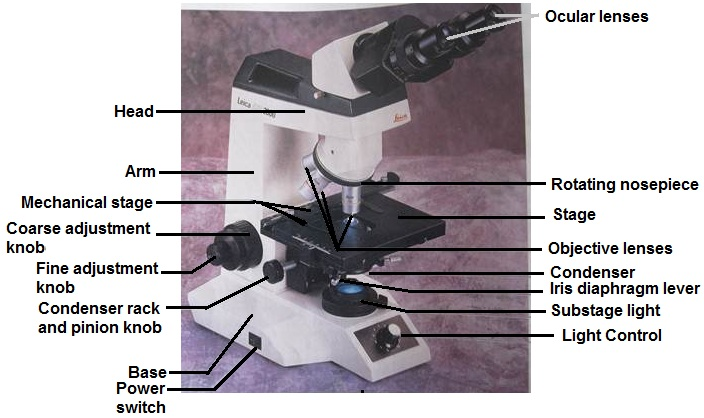Compound Microscope and Its Parts
In this article, we will go over the compound microscope and all the various parts which make it up.
A compound microscope is a microscope consisting of an objective lens and an eyepiece at opposite ends of an adjustable tube.
It is a compound microscope because it uses multiple lenses to collect light from the sample and then a separate set of lens to focus the light into the eye(s) of the user. Compound microscopes are heavier and more complex than other microscopes, such as simple microscopes, due to the different sets of objective lenses.
Below is a picture of a compound microscope:

Base- The base is the bottom piece of the microscope. Its purpose is to support the microscope. When lifting
the microscope up, a hand should be on the arm and the other hand should be under the base.
Substage Light- The substage light, located on the base of the microscope, passes light
directly upward through the microscope. Light controls are located on the microscope base.
Stage- The stage is the platform which a biologist uses to rest the slide on, which is the sample s/he is
examining. The stage has a hole in it to permit light to pass through. Some microscopes
have a stage equipped with spring clips; others have a clamp-type mechanical stage. Both of these hold the slide in
position for viewing.
Condenser- The condenser is the small substage lens that concentrates the light on the specimen. The
condenser may have a rack and pinion knob that raises and lowers the condenser to vary light delivery. The
best position, generally, for the condenser is close to the inferior surface of the stage.
Iris diaphragm lever- The iris diaphragm lever is the arm attached to the base of the condenser that regulates
the amount of light passing through the condenser. The iris diaphragm permits the best possible contrast when vieweing
the specimen.
Coarse adjustment knob- The coarse adjustment knob is a knob which allows you to focus on your
specimen. It magnifies more into a specimen than fine adjustment.
Fine adjustment knob- The fine adjustment knob is a knob which is used for precise focusing once coarse
focusing has been completed.
Head or body tube- The head, or also called the body tube, supports the objective lens system, which is
mounted on the movable nosepieces and the ocular lens or lenses.
Arm- The arm is the vertical portion of the microscope connecting the head and base. When lifting a microscope
up, one hand carries the arm and the other hand is underneath the base.
Ocular lens- Depending on the microscope, there are one or two lenses at the superior end of the head or body
tube. This is the part of a microscope where a user places his or her eyes to view the specimen at hand. An ocular lens
has a magnification of 10x. It increases the apparent size of the specimen by ten times.
Objective lenses- The objective lenses are the adjustable lens system that permits the use of different lenses
that allow a user to view a specimen at different magnification levels. There are scanning lens, low-power lens, high-poer
lens, or an oil immersion lens.
Nosepiece- The nosepiece is the rotating mechanism at the base of the head of the microscope, which carries
3 or 4 objective lenses so that a user can view the specimen at different magnfication levels.
